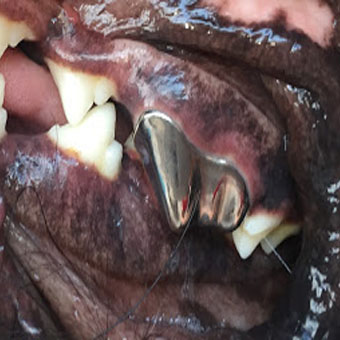
Saturday, June 11, 2016
Even veterinarians can make bad choices when it comes to their pet’s health. I learned this when I discovered my dog, Nikki, had a broken tooth. The cause was a chew item I thought was a safe option for her to gnaw on. But I was wrong- no chew item is risk-free. Sadly my Nikki had to crack three teeth for me to learn that lesson.
Oh yes, it was three broken teeth! But more on that later…
Considering Chew Options
What chew options are there? As the owner of a large powerful chewer, I considered the possibilities for my dog. She has a sensitive stomach and cannot tolerate edible bones or preserved rawhide products. Thank goodness, because feeding my dog pig snouts or pizzles just makes me want to gag. I’m not a fan of real bones- too many patients with broken teeth, gastrointestinal blockages, and even one with a bone shard migrating through the side of its throat.
Soft plastic toys don’t survive the first two minutes with her, and plush toys quickly lose eyes, limbs, and squeakers with her near surgical precision.
So I chose to offer synthetic Nylabone style bones to deal with her chewing drive. Nikki loves the flavors and happily chews away for long periods of time. When the bone looks damaged, I throw it away. It seemed like the perfect solution for a vigorous chewer.
Discovering Her Broken Tooth
>While brushing Nikki’s teeth, I noted a fracture of her upper fourth premolar tooth. This is the largest cheek tooth on a dog or cat’s upper jaw and serves to chew and grind food. The outer layer of the tooth was sheared off, just like a shelf of ice cracking off an iceberg. This type of fracture is common in dogs chewing on an object harder than tooth enamel. Common culprits for this type of tooth damage include antler chews, Nylabones, real bones, or ice.
What to Do With Broken Teeth?
Not all tooth fractures are created equal. An uncomplicated tooth fracture is one in which only the enamel is broken. The tooth is vulnerable to further injury but is not immediately causing the pet pain. A complicated fracture is one in which the break extends beyond the enamel into the pulp chamber.
The pulp of a tooth is the inner layer where the nerve and blood supply runs. Exposure of the pulp not only causes pain but serves as a direct pathway for oral bacteria to cause a tooth abscess or spread through the bloodstream.
How to Treat a Tooth Fracture?
A complicated tooth fracture requires either a root canal or surgical extraction. Leaving a complicated tooth fracture untreated is NOT an option. These teeth hurt and shouldn’t be ignored. Pets won’t whine or cry out in pain with broken teeth, but rather suffer in silence. But after a diseased tooth is addressed, owners commonly note their pet’s overall activity and attitude improve.
The preferred treatment for complicated tooth fractures is a root canal. During a root canal the contents of the pulp are removed, filled in, and the tooth is sealed. After the root canal therapy, the tooth is still functional for normal chewing activities.
If a root canal cannot be pursued, then the tooth should be surgically extracted. This removes the source of pain and potential infection. However, surgical removal of broken teeth may affect the pet’s ability to chew on that side in the future.
Uncomplicated tooth fractures aren’t treated as above, but rather may need outward support of the area with bonding restoration.
My Dog’s Dentist Visit
Dental cleanings and extractions are a daily service at most veterinary practices, but root canals and tooth restorations aren’t commonly available at general practices. I knew I could pull Nikki’s tooth, but to save this tooth in my young dog, I’d need to see a veterinary dental specialist.
Nikki and I arrived at Arizona Veterinary Dental Specialists where she was evaluated by Dr. Chris Visor and determined to have an uncomplicated fracture of her premolar and small uncomplicated breaks on two molars.
Her premolar fracture was limited to the enamel, luckily sparing pulp damage, which means she wasn’t in pain. But the damaged tooth would be at risk for further injury, so she was fitted for a restoration with a metallic crown. (Porcelain isn’t durable in pets so it’s not commonly used) The two other broken teeth had minor damage, so the rough edges were drilled smooth and the tooth surface bonded.
Lesson Learned
After her crown placement, Nikki can’t chew on hard chew bones like before. If she did, it could risk damage to her crown as well as her other teeth. Veterinary dentists warn dog owners of this test of your dog’s chew item- if you whack your knee with your dog’s chew item and it hurts you, it’ll likely break her teeth.
Now I can only imagine scores of dog owners going to their doctors with knee pain….
Take Away Tips: Can You Detect Your Pet’s Broken Tooth?
Most broken teeth are detected during a physical exam by your veterinarian, but some observant pet owners may discover clues to their pet’s broken tooth.
